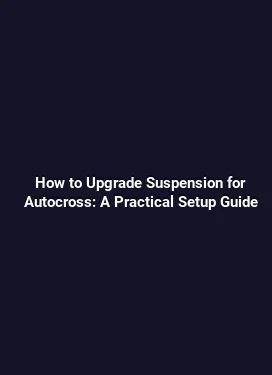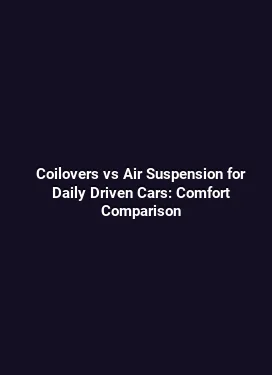Best Alignment Settings for Lowered Cars: Camber, Caster, Toe Guide
Lowering a car can drastically change how it handles, responds to road inputs, and communicates grip through the tires. A well-balanced alignment that accounts for reduced ride height, altered suspension geometry, and dynamic loads is essential for predictable steering, cornering confidence, and tire longevity. This guide dives into practical settings, how to measure them, and how to adjust for common lowered configurations, with real-world considerations for street use and light track days.
Fundamental Roles of Camber, Caster, and Toe in Lowered Setups

Alignment is not a single number but a coordinated system. Each parameter influences how the tire contacts the road, how the chassis rotates under acceleration or braking, and how the vehicle settles after a bump. In lowered cars, the geometry shifts due to axle angles, control arm lengths, and suspension joints moving through different arcs. Understanding the role of each setting helps in tailoring a setup that remains stable as the car transitions from straight-line driving into aggressive cornering.
Camber describes the tilt of the wheel from vertical when viewed from the front or rear. Negative camber tilts the top of the tire inward. In a lowered car, the wheel often gains negative camber under load, which can improve grip at the contact patch during cornering but may wear the inner edge of the tire if excessive at rest. Positive camber is rarely desirable on most road-going lowered builds unless there is a specific race or tire behavior goal. Balancing camber helps maintain a wide contact patch across steering inputs while preserving even wear when the car is loaded through corners.
Caster is the forward or rearward tilt of the steering axis. Positive caster provides self-centering feel and greater stability as speed increases. In lowered vehicles, caster often shifts slightly due to suspension arm geometry, bushings, and knuckle geometry. While caster adjustments are typically conservative on street setups, they influence steering effort, steering return, and high-speed stability. Too little positive caster can result in vague steering; too much can increase steering effort and sensitive responses at low speeds.
Toe refers to the inward or outward pointing of wheels at the front. Toe-in generally reduces toe-out steering looseness and can promote stable tracking, but excessive toe can cause rapid tire wear and a push or pull sensation in the straight-ahead position. For lowered cars, toe values interact with camber to shape tire contact energetics during body roll and suspension rebound. A slight toe-in on most street setups helps maintain straight-line stability, while a small toe-out may be used in certain drift-oriented or aggressive cornering behaviors, always with consideration for tire wear and straight-line stability.
Common Lowered Configurations and Their Alignment Implications
Lowered builds span a spectrum from modest reductions to aggressive drop, often accompanied by different suspension concepts such as coilovers, adjustable sway bars, and strut towers. Each combination affects alignment in distinct ways, and the goal is to achieve predictable behavior across load states: static weight, braking, acceleration, and cornering. The following sections outline typical scenarios and practical targets that crews might tune toward for street-driven, daily-use cars with lowered suspensions.
Moderate Drop with Component Upgrades

In a car lowered about 1.0 to 1.5 inches with upgraded shocks, springs, and control arms, the aim is to preserve enough negative camber under load to keep the tire contact patch balanced through cornering while avoiding excessive inner edge wear. A practical starting point is a camber target around -1.0 to -1.5 degrees at the front and -0.5 to -1.0 degrees at the rear, combined with a small amount of toe-in (roughly 0.05 to 0.15 degrees per axle) to encourage stable tracking. Positive caster in this range supports steering feel without creating heavy steering effort. Tire selection, especially a balanced street performance tire, influences how aggressively to tune these numbers because different compounds behave differently as they heat up and accumulate lateral grip.
Aggressive Drop with Performance Coilovers
When the ride height is significantly lowered, and coilovers are tuned for grip, the suspension geometry can tilt toward more negative camber due to arm angles. A common target for front camber might be -2.0 to -2.5 degrees, with rear camber around -1.5 to -2.0 degrees if the design permits. Toe at the front is often kept near a slight toe-in (0.05 to 0.15 degrees) to maintain straight-line stability, while the rear toe might be close to zero or slightly toe-out (0.0 to -0.1 degrees) to aid turn-in and responsiveness, depending on the chassis and tire behavior. This arrangement prioritizes grip in cornering while accepting some additional inner tire wear as a trade-off for performance handling.
Measurement Techniques: From Static Readings to Dynamic Truth
Accurate alignment starts with solid measurement. Lowered vehicles can exaggerate measurement errors if the car is not on a level surface or if suspension components have settled differently from the reference state. A practical approach combines static alignment checks with dynamic observations through road testing, ensuring the numbers translate into real-world handling. The following steps outline a robust measurement routine that can be performed in a well-equipped shop or a capable garage.
Static Alignment Checks
Begin by ensuring the vehicle is on a level surface, with the tires inflated to the mounted pressures and the car fully settled on the suspension. Use a reputable alignment rack or a calibrated optical or laser-based toolset. Record the following values for each axle: camber, toe, and, where the instrument provides it, caster. Compare the numbers against your target ranges and identify any deviation caused by ride height, tire wear, or bushing conditions. When lowering a car, it is common to see an increase in negative camber in the front due to the geometry shift; this should be accounted for in the target values to avoid under- or over-compensation at ride height.
After initial readings, inspect tire wear patterns. Even wear indicates a balanced setup. If you notice inner-edge wear on the front tires with pronounced negative camber, reassess your camber target to reduce negative camber slightly or adjust toe to compensate for load distribution during cornering. Conversely, outer-edge wear suggests reducing negative camber or increasing toe-in to shift contact toward the outer shoulder during load states.
Dynamic Evaluation and Road Testing
Numbers alone cannot capture dynamic behavior. Conduct a controlled road test over a mix of surfaces, paying attention to turn-in response, mid-corner stability, and how the car settles after a bump. Observe the steering column feel, feedback through the chassis, and any tendency to oversteer or understeer as throttle and braking inputs are varied. If the car exhibits a tendency to pull under braking or a push through mid-corner, minor adjustments in toe or camber on the respective axle can help balance the weight transfer and tire contact distribution during dynamic states.
In practice, small incremental changes yield meaningful improvements. For example, dialing in 0.05 degrees of toe-in at the front can tighten straight-line stability without compromising turn-in, while adjusting camber by 0.1 to 0.2 degrees can alter tire wear and grip distribution in a way that aligns with your driving style and road conditions. It is often helpful to log changes with dates and driving conditions to build a reproducible tuning history for the specific vehicle.
Hardware Considerations: Bushings, Arms, and Alignment Pros
Lowered setups stress suspension joints differently. Worn bushings can mimic alignment changes or introduce unwanted dynamic toe and camber shifts under load. When chasing precision, inspect control arm bushings, ball joints, tie rod ends, and wheel hubs. Upgrading to stiffer or spherical bushings can reduce unwanted play, but they may alter ride quality and NVH (noise, vibration, harshness). Some arms provide adjustable camber or toe settings, enabling precise tuning without replacing major components. Before making large changes, verify that all fasteners are torqued to specification and that no suspension mounts exhibit play that could skew measurements during dynamic testing.
A reliable alignment often benefits from a chassis dyno or a weight-scanning approach to roughly estimate the effect of corner weights on alignment targets. While not always necessary, understanding how weight distribution shifts with load and cornering can guide more accurate adjustments, especially on front-heavy or rear-heavy layouts where weight transfer dynamics influence contact patch behavior significantly.
Tire and Wheel Considerations for Lowered Alignments
Tires are the interface between the car and the road, and their interplay with alignment is pivotal. With lowered suspensions, wheel geometry and tire profile interact with the suspension more aggressively. Low-profile tires can transmit road irregularities more directly, making even small alignment tweaks more noticeable. A broader contact patch and optimized footprint can help absorb load during cornering and braking, but this comes with trade-offs for wear patterns and ride comfort.
When selecting tires for a lowered alignment, consider compounds that tolerate temperature swings, maintain consistent grip across a wide load range, and offer predictable wear. The interaction between tire sidewall stiffness, camber, and toe is central: higher stiffness can reduce camber loss under load but may reduce forgiveness in imperfect road surfaces. Track-oriented tires may tolerate more aggressive camber and toe management, while daily-driver tires emphasize consistent wear and predictable behavior under mixed conditions.
Practical Step-by-Step Tuning Plan for a Lowered Vehicle
Successful tuning often follows a structured approach. Here is a practical plan that blends measurement, testing, and incremental refinement to achieve a balanced, predictable setup for a street-driven lowered car.
Establish baseline measurements at the target ride height, recording camber, toe, and any available caster figures on both axles. Note weight distribution and tire pressures.
Set conservative targets to start, such as front camber around -1.0 to -1.5 degrees, rear camber around -0.5 to -1.0 degrees, front toe-in 0.05 to 0.15 degrees, and rear toe near 0.0 to -0.1 degrees. Use the suspension design as a constraint rather than pushing every parameter to extremes.
Perform a road test focusing on straight-line stability, turn-in response, mid-corner stability, and exit behavior. Note any vagueness, push or snap tendencies, and steering feel.
Make small adjustments in 0.05 to 0.10 degree increments, retest, and compare. Focus on improving predictable grip and preserving even tire wear rather than chasing extreme numbers.
Evaluate wear patterns after several hundred miles of mixed driving. If observed inner-edge wear dominates, reduce negative camber slightly and/or adjust toe to compensate for load under cornering.
Periodically recheck alignment after suspension service or changes to ride height to ensure the setup remains within the intended targets.
These steps require patience and careful documentation. The goal is a harmonious balance between straight-line stability, precise steering, and even tire wear across everyday driving and occasional aggressive cornering occasions.
Case Studies: Real-World Outcomes from Thoughtful Alignments
In one practical scenario, a compact sedan with a modest 1.2-inch drop benefited from a front camber of -1.2 degrees and a rear camber of -0.8 degrees, paired with a front toe-in of 0.08 degrees and rear toe of -0.02 degrees. The result was a car that tracked cleanly in a straight line, with improved turn-in response and balanced tire wear. Drivers reported confident behavior during mid-corner transitions and less understeer at the limit when entering aggressively, thanks to the managed contact patch distribution. In another example, a track-oriented setup with aggressive drop used a front camber of -2.3 degrees and a rear camber of -1.8 degrees, with subtle toe adjustments. The car achieved notable grip at high lateral loads, but required a sensitive touch on steering inputs to maintain stability on uneven pavement, illustrating the importance of tailoring alignment to the specific driving context and tire characteristics.
These case studies emphasize that there is no universal setting; the best alignment for a lowered car is the one that delivers predictable behavior across the most common driving scenarios while respecting tire wear and component longevity. Field testing with a patient, iterative approach yields the most reliable results, particularly when combining different chassis geometries and suspension components.
Maintaining Alignment Integrity Through Time
Lowered builds demand ongoing maintenance to preserve the alignment’s integrity. Recheck alignment after major driving events, such as hitting heavy road crowns, potholes, or after suspension service. Monitor tire wear patterns and look for changes that indicate shifts in camber or toe due to bushing wear or arm deformation. Regular checks help preserve the intended handling characteristics and keep tire life optimized across seasons and weather conditions.
For enthusiasts aiming to extract every bit of performance from a lowered vehicle, the final balance often rests on harmonizing drivers’ inputs with tire behavior, chassis stiffness, and the subtle, continuous adjustments that come from experience and careful observation. The result is a vehicle that communicates clearly through steering, responds predictably to inputs, and maintains grip that inspires confidence on a wide range of road surfaces.






